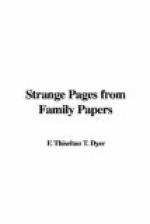Occasionally similar bargains have been rendered ineffectual by cunning device. In the north wall of the church of Tremeirchion, North Wales, has long been shown the tomb of a former vicar, who was also celebrated as a necromancer, flourishing in the middle of the fourteenth century. It is reported that he proved himself more clever than the Wicked One himself. A bargain was made between them that the vicar should practise the black art with impunity during his life, but that the devil should possess his body after death, whether he were buried within or without the church. But the worthy vicar dexterously cheated his ally of his bargain by being buried within the church wall itself. A similar tradition is told of other localities, and amongst them of Barn Hall, in the parish of Tolleshunt Knights, on the border of the Essex marshes. In the middle of a field is shown an enclosed uncultivated spot, where, the legend says, it was originally intended to erect the hall, had not the devil come by night and destroyed the work of the day. This kind of thing went on for some time, when it was arranged that a knight, attended by two dogs, should watch for the author of this mischief. He had not long to wait, for, in the quiet of the night, the Prince of Darkness made his appearance, bent on his mischievous errand. A tussle ensued, in the course of which, snatching up a beam from the building, he hurled it to the site of the present hall, exclaiming:
“Wheresoe’er this
beam shall fall,
There shall stand Barn Hall.”
But the devil, very angry at being thus foiled by the knight, vowed that he would have him at his death, whether he was buried in the church or out of it. “But this doom was averted by burying him in the wall—half in and half out of the church. At Brent Pelham Church, Herts, too, there is the tomb of one Piers Shonkes, and there is a tale current in the neighbourhood that the devil swore he would have him, no matter whether buried within or without the church. So, as a means of escape, he was built up in the wall of the sacred edifice.”
Another extraordinary story has long been told of Hermitage Castle, one of the most famous of the Border Keeps in the days of its splendour. It is not surprising, therefore, that for many years past it has had the reputation of being haunted, having been described as:—
“Haunted
Hermitage,
Where long by spells mysterious
bound,
They
pace their round with lifeless smile,
And
shake with restless foot the guilty pile,
Till sink the smouldering
towers beneath the burdened ground.”




